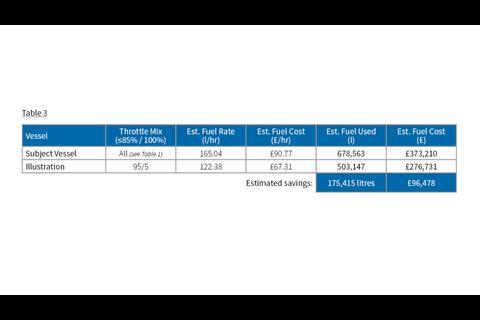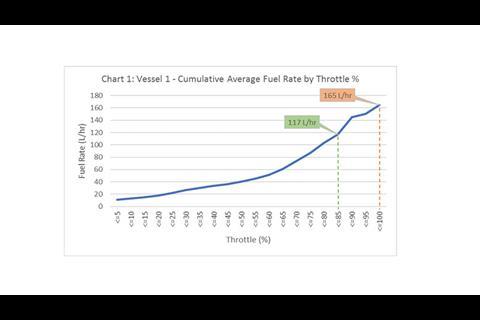AST iRAMS Maritime Fuel Saving Analysis
(referenced graphs and tables can be viewed in the above image carousel)
GOAL
To demonstrate potential cost savings for vessel/fleet owners commonly implemented in the land Fleet Management industry through use of AST’s Intelligent Remote Asset Management System (iRAMS) telemetry to monitor vessel parameters, and influence skipper behaviour to drive down operating costs and reduce environmental emissions. Fifteen years of land fleet management telemetry has shown cost savings in the transport industry and the experience learnt can be applied to the maritime sector with iRAMS telemetry.
WHAT WE DID
A CTV vessel was identified, via the iRAMS alerting feature, that was clearly using excessive throttle on a regular basis, resulting in higher than optimal fuel consumption rates and emissions when bench marked against similar CTV vessels. Reviewing the iRAMS historical data, configurable alerts and reports it was clear the way this specific vessel was being skippered was impacting materially on the optimum fuel consumption.
iRAMS captured data in its raw state, directly from a vessel’s CAN bus, which was used without any manipulation or alteration to analyse the fuel rates for the subject vessel.
Using the dual reporting feature in iRAMS, data was extracted from an actual working Crew Transfer Vessel (CTV) servicing the UK wind farm industry. The data set contained fuel rate vs throttle covering a 12-month period (27/03/2018 – 25/03/2019).
The throttle values were grouped in increments of 5% (e.g. ≤5%, ≤10%, ≤15% … ≤100%) and the cumulative fuel rates that fell within each range were then averaged, giving an approximate fuel use rate for each interval, as illustrated in Chart 1 (shown above in image carousel).
This approach was considered to give a fair approximation of fuel rate across the range of throttle positions used on a vessel under normal operating conditions.
By reviewing the results, it was determined that a throttle position of approximately 85% might give the best balance between lower fuel rate and practical vessel operation. Operating at 85% throttle showed a potential fuel rate saving of approximately 29%!
It was recognised as unrealistic, however, to expect a vessel to never use 100% throttle (e.g. when operating against the tide, when trying to avoid weather fronts, or for other operational needs influenced by safety). In fact, the subject vessel’s data revealed that 100% throttle was used for 19.4% of its operational time, equivalent to 698 hours at 100% throttle over 12 months.
To place some context around the subject vessel’s method of operation, we compared behaviour of similar CTVs, where iRAMS was installed and actively monitored by the vessel operators. This analysis showed that other similar vessels were using 100% throttle for a fraction of their operating time, instead favouring the range >80 to ≤90. Table 1 (shown above in image carousel).
With this information in mind, the model was refined to indicate costs and savings where 100% throttle was used for 5% of ‘engine on’ hours and ≤85% throttle for the remaining 95% of the time.
Table 2 (shown above in image carousel) illustrates how this mixed fuel approach was calculated. Fuel usage was calculated using iRAMS data from the subject vessel, an estimated fuel cost of £0.55 per litre, and an estimated 4,111 hours of total ‘engine on’ hours (2 x 2,056 hours per engine). Interestingly, data also showed that over a 12 month period of time, the fuel rate at 100% throttle averaged 222.40 litres per hour.
Table 3 (shown above in image carousel) shows how the throttle mix impacts on fuel costs. Influencing skipper behaviour and reducing the proportion of time that 100% throttle is used can yield a potential 25.9% saving when compared with the subject vessel’s actual throttle use.
IN SUMMARY
It is clear that using AST iRAMS actively, operation can be made more efficient (up to 25%) in fuel savings by influencing skipper behaviour. Beyond fuel savings iRAMS also; reduces oil consumption, reduces engine wear, provides real time monitoring of position, compares twin engines for performance, provides geo-fence capability to avoid dangerous areas, provides on task and off task data alerts for cost and risk control, and archives data for performance analysis. To see how iRAMS can complement the way you influence skipper behaviour to comply with your fleet policy on efficient vessel operation, contact AST Marine Sciences and start saving today.
Please visit www.ast-msl.co.uk for more information.
Share this article















